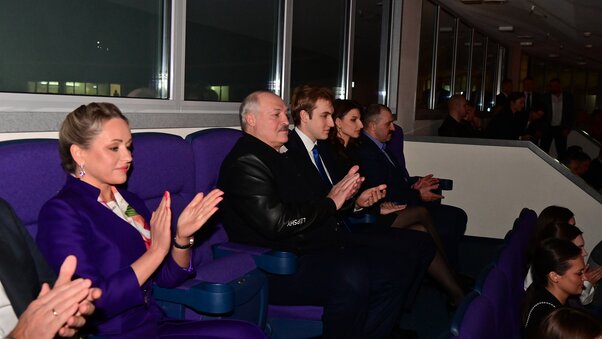Working trip to Oshmyany District, Grodno Oblast
- 18
- 2
Belarusian President Aleksandr Lukashenko made a working trip to Oshmyany District, Grodno Oblast, on 26 March.
Possible border provocations on the part of the neighboring states should be met with tough response, the head of state said as he inspected one of the facilities that is undergoing the combat readiness check.
“I will say this publicly: any provocation must be suppressed by force of arms. No joking around. Those who violate the state border should be destroyed. Don’t treat them with kid gloves. That’s how we will do it,” said the head of state. “Therefore, those who violate the state border should be destroyed. They understand only force,” Aleksandr Lukashenko said.
Commander of the Northwestern Operational Command Aleksandr Naumenko reported that at present the situation in the area across Belarus’ northwestern border remains difficult and tensions are likely to escalate. A testimony to that is the construction of engineering structures, including anti-tank ditches and firing positions, across Belarus’ border. Material supplies and ammunition are being amassed in warehouses.
The neighboring side has beefed up border security across Belarus’ northwestern border. The total number of troops involved in protecting their border with Belarus approximates 3,200, including up to 2,800 in Lithuania and up to 500 in Latvia.
Military contingents of NATO states that were deployed in the area to perform various tasks include up to 7,700 people in Estonia, Latvia and Lithuania. Military units of NATO's joint and combined armed forces, including in the Baltic countries and Poland, are engaged in operational and combat training.
Aleksandr Naumenko noted that the Quadriga 2024 exercise is currently underway in a number of countries, including Lithuania and Poland. As part of the ongoing exercise, three battalions (German infantry and mechanized battalions and a US tank battalion) are deployed at the Pabradė Training Area, which is 15 km from the state border).
The battalions stationed at the Pabradė Training Area may be used to carry out provocative actions near the border using sabotage and reconnaissance groups and illegal armed formations.
Aerial reconnaissance of Belarus is also conducted extensively. An average of 4-5 reconnaissance aircraft sorties are recorded every day. Currently, 132 combat aircraft from the NATO air force group are based in the area adjoining Belarus’ northwestern border.
“Do they seriously think that we and the Russians are harboring plans to attack them? Why would they be digging anti-tank ditches... We’re not going to go there,” the head of state noted.
In this regard, Aleksandr Naumenko remarked that any preparation for war and war itself certainly benefit someone economically.
“We should not lower our guard. We know for sure that if we drop our guard, they will attack us. Have no doubt about it. But we are not going to go there,” the Belarusian leader emphasized.
During the working trip the President answered reporters’ questions.
According to the head of state, the development of the army should focus on peculiarities of modern warfare. Belarus has a lot of forests and swamps. This is why in addition to cutting-edge high-precision weapons the army also needs conventional weapons and skillful actions of military personnel in the field: “How can they [the enemy] move tanks, armored personnel carriers and so on here? If they move along roads, we can cut the roads. They cannot pass through forests. It is our land. We know every bit of it. We can set up an ambush and destroy them. A tank can be destroyed with an ordinary grenade launcher or a similar tank.”
“Don’t forget that ordinary soldiers, conventional weapons accomplish the key mission in any war. Plus reinforcements. The war in Ukraine demonstrates that unmanned aerial vehicles are very effective: recon and strike drones,” the President said.
Radio warfare solutions are also important, including for fighting drones. “It is a novelty one cannot do without,” the Belarusian leader stressed.
Apart from that, counterbattery fire is important. Artillery has always been considered the god of war. Artillery is still very important, very valuable, the President said.
Aleksandr Lukashenko pointed out that back in the day Belarus did not abandon basic things and conventional weapons. Practice demonstrates that those are in demand and effective in modern armed conflicts. The President gave a concrete example: “We didn’t abandon mines and mine emplacement back in the day. I remember they suggested getting rid of mines to me as a young President. I told them not to hurry up and destroy them. Look at Ukraine’s experience. They lay mines on approaches.”
The head of state explained that, for instance, Russians laid mine fields on approaches to their trenches and Ukrainian soldiers could not get across these mine fields during a failed counteroffensive.
“The same can be said about assault rifles, machine guns, and grenade launchers. A war is impossible without them today. Tanks, armored personnel carriers and things like that. Conventional weapons have demonstrated their might,” the head of state said.
Nevertheless, Belarus has modern air defense systems capable of destroying the enemy’s aerial targets. “Whatever an S-400 may be, although it is a very sophisticated air defense system, no war can be fought today without conventional weapons and soldiers, without officers and commanders,” the President is convinced.
Aleksandr Lukashenko also drew attention to military training. “We have started teaching more. We now have to resolve the problem of training reserve personnel. Including officers. They need to be taught because they will have to teach soldiers later on. They have to be in control,” he said.


